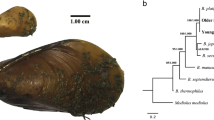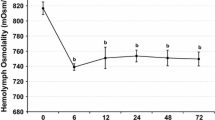Abstract
The euryhaline gastropod Theodoxus fluviatilis is found in northern Germany in freshwater or in brackish water habitats in the Baltic Sea. Previous studies have revealed that individuals from both habitats are not distinguishable by morphological characters or by sequence comparison of DNA encoding 16S RNA or cytochrome C. As reported in this study, animals collected in the two habitats differ substantially in their physiological ability to adapt to different salinities. Comparison of accumulation rates of ninhydrin-positive substances (NPS) in foot muscle upon transfer of animals to higher medium salinities revealed that brackish water animals were perfectly able to mobilize NPS, while freshwater animals had only limited ability to do so. In an attempt to explore whether this difference in physiology may be caused by genetic differentiation, we compared protein expression patterns of soluble foot muscle proteins using 2D gel electrophoresis and silver staining. Of the 40 consistently detected protein spots, 27 showed similar levels in protein expression in animals collected from freshwater or brackish water habitats, respectively. In 12 spots, however, protein concentration was higher in brackish water than in freshwater animals. In four of these spots, expression levels followed increases or decreases in medium salinities. In a different set of 4 of these 12 spots, protein levels were always higher in brackish water as compared to freshwater animals, regardless of their physiological situation (14 days in artificial pond water or in medium with a salinity of 16‰). The remaining 4 of the 12 spots had complex expression patterns. Protein levels of the remaining single spot were generally higher in freshwater animals than in brackish water animals. These expression patterns may indicate that freshwater and brackish water animals of T. fluviatilis belong to different locally adapted populations with subtle genetic differentiation.






Similar content being viewed by others
References
Blum H, Beier H, Gross HJ (1987) Improved silver staining of plant proteins, RNA and DNA in polyacrylamide gels. Electrophoresis 8:93–99
Bradford MM (1976) A rapid and sensitive method for the quantitation of microgram quantities of protein utilizing the principle of protein-dye binding. Anal Biochem 72:248–254
Bunje PME (2005) Pan-European phylogeography of the aquatic snail Theodoxus fluviatilis (Gastropoda: Neritidae). Mol Ecol 14:4323–4340
Bunje PME, Lindberg DR (2007) Lineage divergence of a freshwater snail clade associated with post-Tethys marine basin development. Mol Phylogenet Evol 42:373–387
Butenko O (2001) Mollusks of Theodoxus genus (Gastropoda, Neritidae) in the Odessa Bay (The Black Sea). Ecol Morya 58:27–28
Colgan DJ, Ponder WF, Beacham E, Macaranas JM (2003) Gastropod phylogeny on six segments from four genes representing coding or non-coding and mitochondrial or nuclear DNA. Mollusc Res 23:123–148
Gilles R, Jeuniaux C (1979) Osmoregulation and ecology in media of fluctuating salinity. In: Gilles R (ed) Mechanisms of osmoregulation in animals. Wiley, Chichester, pp 581–608
Henry RP, Mangum CP, Webb KL (1980) Salt and water balance in the oligohaline clam, Rangia cuneata. J Exp Zool 211:11–24
Jaeckel SGA (1950) Die Mollusken der Schlei. Arch Hydrobiol 44:214–270
Kangas P, Skoog G (1978) Salinity tolerance of Theodoxus fluviatilis (Mollusca, Gastropoda) from freshwater and from different salinity regimes in the Baltic Sea. Estuar Coast Mar Sci 6:409–416
Larsen PF, Nielsen EE, Williams TD, Loeschcke V (2008) Intraspecific variation in expression of candidate genes for osmoregulation, heme biosynthesis and stress resistance suggests local adaptation in European flounder (Platichthys flesus). Heredity 101:247–259
Neumann D (1960) Osmotische Resistenz und Osmoregulation der Flußdeckelschnecke Theodoxus fluviatilis L. Biol Zentralbl 5:585–605
Pierce SK (1982) Invertebrate cell volume control mechanisms: a coordinated use of intracellular amino acids and inorganic ions as osmotic solute. Biol Bull 163:405–419
Ponder WF, Lindberg DR (1997) Towards a phylogeny of gastropod molluscs: an analysis using morphological characters. Zool J Linn Soc 119:83–265
Ravigné V, Dieckmann U, Olivieri I (2009) Live where you thrive: joint evolution of habitat choice and local adaptation facilitates specialization and promotes diversity. Am Nat 174:E141–E169
Ruhemann S (1910) CXXXII—cyclic di- and tri-ketones. J Chem Soc Trans 97:1438–1449
Vinu Chandran R, Damodaran R (2000) Oxygen consumption, ammonia excretion and total ninhydrin positive substances in black clam Villorita cyprinoides (Pelecypoda) exposed to various salinities. Indian J Mar Sci 19:80–82
Zettler ML, Frankowski J, Bochert R, Röhner M (2004) Morphological and ecological features of Theodoxus fluviatilis (LINNAEUS, 1758) from Baltic brackish water and German freshwater populations. J Conchol 38:305–316
Acknowledgments
The authors thank Christina Pommerenke for excellent experimental help in some of the experiments and Klaus Fischer (Zoology, University of Greifswald) and anonymous reviewers for helpful comments on the manuscript. Permissions for the collection of animals were granted by Landesumweltamt Brandenburg, Potsdam, Germany (N24440-236-NF/1167-2002) and by Nationalparkamt Vorpommersche Boddenlandschaft, Born, Germany (24-5303.3).
Author information
Authors and Affiliations
Corresponding author
Additional information
Communicated by G. Heldmaier.
Rights and permissions
About this article
Cite this article
Symanowski, F., Hildebrandt, JP. Differences in osmotolerance in freshwater and brackish water populations of Theodoxus fluviatilis (Gastropoda: Neritidae) are associated with differential protein expression. J Comp Physiol B 180, 337–346 (2010). https://doi.org/10.1007/s00360-009-0435-4
Received:
Revised:
Accepted:
Published:
Issue Date:
DOI: https://doi.org/10.1007/s00360-009-0435-4




